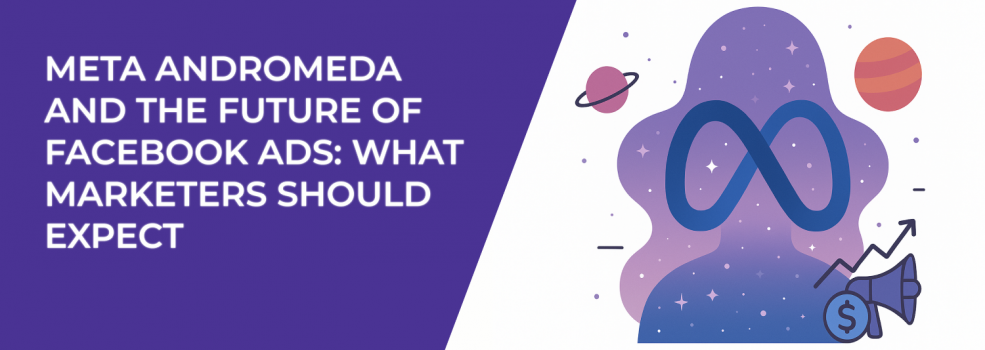Facebook advertising is changing quickly. For years, advertisers relied on targeting — picking interests, demographics, and behaviors. But today, a lot of that heavy lifting is handled by artificial intelligence. The newest upgrade, Meta Andromeda, is a powerful AI system that helps decide which ads people see and how they’re matched to the right audience.
It sounds technical, but the impact is simple: ads get more personalized, campaigns scale faster, and results improve. Still, there are trade-offs every marketer should consider. Let’s walk through what Andromeda really means for your ad strategy.
Why Meta Andromeda Matters
Every ad you launch has to compete with millions of others. Meta’s system looks at all of them and decides which ones a person is most likely to care about. That first step, called retrieval, is where Andromeda comes in.
Andromeda is faster and smarter than the systems before it. It runs on new hardware designed to handle massive data loads and can find subtle patterns in what people click, watch, and buy. That allows Meta to deliver ads that feel more relevant.
Early tests show an 8% boost in ad quality after Andromeda was introduced. At Facebook’s scale, that means more engagement and more conversions for advertisers. For a single campaign, it might not seem dramatic, but across thousands of campaigns, these small lifts add up to big savings and better performance.
If you want to understand how Meta’s automation ties into campaign design, see Unlock Meta Advantage+: The Smarter Way to Boost Your Facebook Ads.
How Meta Andromeda Powers Advantage+
To really see Andromeda’s value, look at how it connects with Advantage+ campaigns. Advantage+ sales campaigns and Advantage+ creative already use AI to automate budgets, placements, bidding, and even ad creative variations. They’re designed to test a massive number of ad combinations at once.
But here’s the catch: the more advertisers use Advantage+, the more ad variations pour into the system. With features like AI-generated images, background changes, and automated copy tweaks, one advertiser can easily go from producing 3–5 ads a week to 50 or more. Now multiply that by millions of advertisers worldwide — the system suddenly has billions of ad candidates to process.
That’s where Andromeda comes in.
Andromeda acts as the retrieval engine that organizes and filters this flood of ads. It narrows millions of possible creatives down to a few thousand highly relevant ones before the system ranks them for delivery. Without Andromeda’s advanced neural networks and indexing, Advantage+ couldn’t work at this scale.
In practice, the workflow looks like this:
-
Advantage+ generates and automates a huge variety of ad variations.
-
Andromeda processes those creative options rapidly, ensuring only the most relevant ones are served to each person.
-
Together, they enable real-time personalization — each user sees the variation most likely to resonate with them.
Meta reports that campaigns using Advantage+ creative with Andromeda behind the scenes deliver stronger results, including higher click-through rates and noticeable conversion lifts.
Think of Advantage+ as the front-facing tool for advertisers and Andromeda as the engine under the hood that makes its speed and accuracy possible.
Creative Diversification: Why Variety Wins
One of the biggest changes for marketers is the shift toward creative diversification. This simply means producing more versions of your ads — different images, videos, copy styles, and messages — so the system has more to work with.
Instead of focusing only on finding a “perfect” audience, you give the algorithm plenty of creative options. Andromeda can then test these variations and figure out which ones connect with which people.
Pros of creative diversification
-
You can reach more types of people. Not everyone responds to the same message. A fun video might pull in younger users, while a product-focused image could work better for shoppers ready to buy.
-
Your ads stay fresh. Showing the same creative too often makes people tune out. A steady rotation of new ideas keeps attention high.
-
You get built-in testing. By uploading more versions, you allow Meta’s AI to run constant experiments and learn what performs best.
Cons of creative diversification
-
It takes time and resources. Producing dozens of unique ads every month isn’t easy, especially for small businesses without large creative teams.
-
It can get messy. With so many versions running, it’s harder to know exactly what caused a campaign to succeed or fail. Was it the design, the headline, or the audience?
-
More isn’t always better. If the quality of your creatives isn’t strong, adding more versions won’t magically improve results. Weak ideas stay weak, even when tested at scale.
If you’re curious how AI is shaping this space more broadly, you’ll find helpful insights in AI in Advertising: 5 Trends Marketers Can’t Afford to Ignore.
Advantage+ Automation: A Double-Edged Sword
Meta has also been pushing advertisers toward Advantage+ campaigns. These tools use AI to handle budgets, targeting, and placements automatically. Advantage+ creative even helps generate new ad variations using AI, from backgrounds to copy tweaks.
Advantages of automation
-
You save time. Media buyers no longer need to adjust bids or placements every day — the system does it.
-
Your budget works harder. Campaigns with Advantage+ often report a 9% lower cost per action, meaning you spend less for the same result.
-
Testing becomes easier. With automation, you can upload 20 or 30 creatives and let the system figure out which ones to scale.
Disadvantages of automation
-
You lose visibility. Advertisers don’t always know why the system chose one ad over another, which makes learning harder.
-
Less human control. Over time, you might rely so much on automation that your campaigns all start to look the same.
-
Risk of dependence. If Meta changes its algorithm, your performance can shift overnight — and there’s little you can do to prevent it.
For a deeper dive into scaling with these tools, see Scale Your Facebook Ads with Automation Without Sacrificing Quality.
What Marketers Should Do Now
So how can you adapt your ad strategy to work with Andromeda and automation, while avoiding the risks? Here are some practical steps:
-
Increase creative output — but focus on quality.
Try to build a process where new creatives are produced every week. This doesn’t mean you need a studio team. Simple background variations, copy tweaks, or short video edits can make a big difference. -
Don’t hand everything to automation.
Use Advantage+ campaigns for efficiency, but keep a few manual tests running. This way, you can compare performance and keep learning what works for your audience. -
Look beyond surface metrics.
Clicks and impressions are helpful, but the real question is: did the creative move people closer to buying? Track conversions and sales tied to creative themes, not just ad sets. -
Stay flexible.
The pace of change is fast. Build systems where creative and campaign ideas can be updated quickly without weeks of approvals. Agility will give you an edge. -
Diversify your channels.
While Meta is still king in social advertising, don’t rely on it alone. Explore TikTok, YouTube, or even programmatic ads so you’re not fully dependent on one platform.
In short, the best approach is to combine automation with strong creative strategy, making sure your brand doesn’t lose its voice while scaling with AI.
The Bigger Picture
Meta Andromeda represents the direction digital ads are heading: more personalization, faster testing, and larger-scale automation. For advertisers, this is both exciting and intimidating.
On the plus side, you get smarter delivery, better performance, and the chance to reach audiences you might never have considered. On the downside, it demands more creative work, more testing discipline, and a willingness to trust algorithms that aren’t always transparent.
In the short term, marketers who embrace creative variety and lean on automation will see strong returns. But the real winners will be the brands that mix AI with human creativity, using technology to scale their ideas — not to replace them.
Meta Andromeda is the engine powering the next era of Facebook ads. But remember: an engine only moves you forward if you steer it in the right direction.

